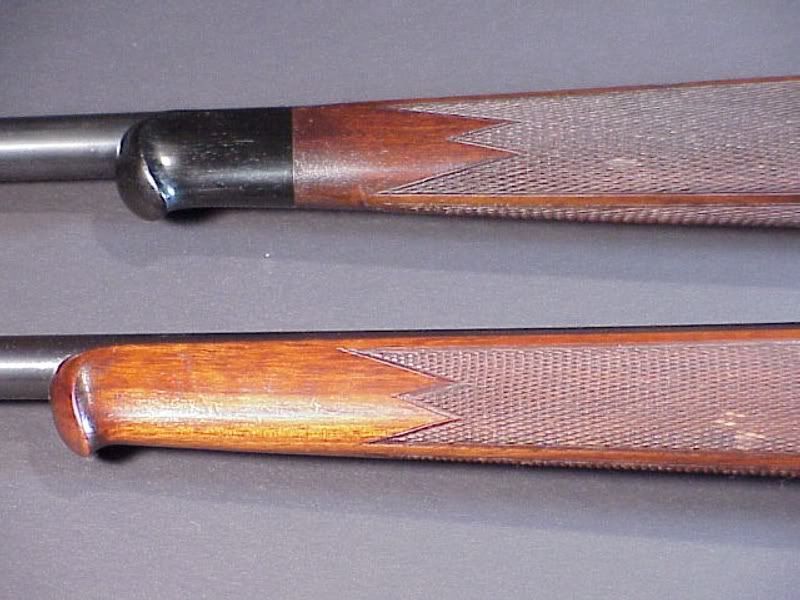|
|
|
S |
M |
T |
W |
T |
F |
S |
|
|
1
|
2
|
3
|
4
|
5
|
6
|
|
7
|
8
|
9
|
10
|
11
|
12
|
13
|
|
14
|
15
|
16
|
17
|
18
|
19
|
20
|
|
21
|
22
|
23
|
24
|
25
|
26
|
27
|
|
28
|
29
|
30
|
31
|
|
|
|
|
|
2 members (SKB, welder),
1,261
guests, and
5
robots. |
|
Key:
Admin,
Global Mod,
Mod
|
|
|
Forums10
Topics39,646
Posts563,699
Members14,602
| |
Most Online9,918
Jul 28th, 2025
|
|
|
|
Joined: Dec 2001
Posts: 6,881
Sidelock
|
OP

Sidelock
Joined: Dec 2001
Posts: 6,881 |
Michael, Is there something not mentioned yet that should stand out? No, I think that most of the things that make this a Lion have been touched on, divided checkering pattern on forend, checkering pattern and checkering running all the way to the inletting. Remember you have only been given a little info, more to come.
MP Sadly Deceased as of 2/17/2014
|
|
|
|
|
Joined: Dec 2001
Posts: 6,881
Sidelock
|
OP

Sidelock
Joined: Dec 2001
Posts: 6,881 |
On the majority of Mr. Lions stocks fully 90% or more have a schnabel forend, even when he used horn. 
MP Sadly Deceased as of 2/17/2014
|
|
|
|
|
Joined: Nov 2008
Posts: 83
Sidelock
|

Sidelock
Joined: Nov 2008
Posts: 83 |
Dont know if this is relvant. I have several 1930-1940 Swedish Husqvarna rifles and they have checkering that runs into the inlet, and simular patern also those schnabel tips especialy the top one are done like the old huskys. Maybe the maker had european or swedish influense, maybe not?
|
|
|
|
|
Joined: Dec 2001
Posts: 6,881
Sidelock
|
OP

Sidelock
Joined: Dec 2001
Posts: 6,881 |
He also liked very long forearms. 
MP Sadly Deceased as of 2/17/2014
|
|
|
|
|
Joined: Dec 2008
Posts: 678 Likes: 15
Sidelock
|

Sidelock
Joined: Dec 2008
Posts: 678 Likes: 15 |
|
|
|
|
|
Joined: Dec 2001
Posts: 6,881
Sidelock
|
OP

Sidelock
Joined: Dec 2001
Posts: 6,881 |
No, E. Lion, do you have enough information to comfortably attribute a rifle you see in the future to Mr. Lion or do you need more or better information? How can I do my job better so anyone who sees a Lion rifle can identify it?
MP Sadly Deceased as of 2/17/2014
|
|
|
|
|
Joined: Dec 2008
Posts: 678 Likes: 15
Sidelock
|

Sidelock
Joined: Dec 2008
Posts: 678 Likes: 15 |
The long forearm ending in a schnabel coupled with the distinctive checkering patterns will be an eye-grabber for me in future. Any further ID features would be useful to confirm the gun's origin should I stumble on to one.
I guessed Ross King because I know he worked with Pachmayr at one point. Having a dim memory of an old photo of the two of them at a workbench which could be similar to the one shown above, coupled with my obviously faulty memory of someone having already guessed Pachmayr fueled my supposition. A re-check of earlier posts on this thread showed me my error. I'm now thinking Pachmayr, from the European influence present in these early sporters. My deductions may be lousy, but deducing I am!
|
|
|
|
|
Joined: Dec 2001
Posts: 6,881
Sidelock
|
OP

Sidelock
Joined: Dec 2001
Posts: 6,881 |
Deduce Away! Mr. Lion lived in a hotel and worked out of a shop in the basement. The point of this is not to figure out who he is but if you can identify his work. From some of the speculation I could do a better job on the makers I have written about. As for Ross King there is an article about him in the March issue of "Precision Shooting". It seems to me that if a maker marked his work most don't look beyond this.
MP Sadly Deceased as of 2/17/2014
|
|
|
|
|
Joined: Jan 2009
Posts: 231
Sidelock
|

Sidelock
Joined: Jan 2009
Posts: 231 |
Michael: When I put it all together I keep coming up with a lot of maybes but only one probable...Ludwig Wundhammer. Great Exercise!!! Warmest Jerry
The Sons of Alvin Linden
|
|
|
|
|
Joined: Sep 2008
Posts: 465
Sidelock
|

Sidelock
Joined: Sep 2008
Posts: 465 |
WEll when you look at the various example rifles there is a pattern of long, slim forend with schnable and two panel checkering on the forend that is distinctive, Two panel checkering on the grip that meets at the top without a border between the panels rather than crossing the top and checkering right up to the inletting on the grip. I'm not certain but at least one rifle may have a Wundhammer swell. The examples shown don't appear to have a cheekpiece but the rifles in the rack next to the checkering cradle have the pancake style cheekpiece. Being a mere novice at these classic rifles I don't know the maker but I think I might now recognize one of his rifles.
Each of the top grade custom riflesmiths seem to have something distictive about their rifles that allow identification or, at least, a suspicion of authorship. It seems enough to make a "Field Guide to Classic Custom Rifles" much like the Peterson Field Guide series.
Jerry Liles
|
|
|
|
|
|
|